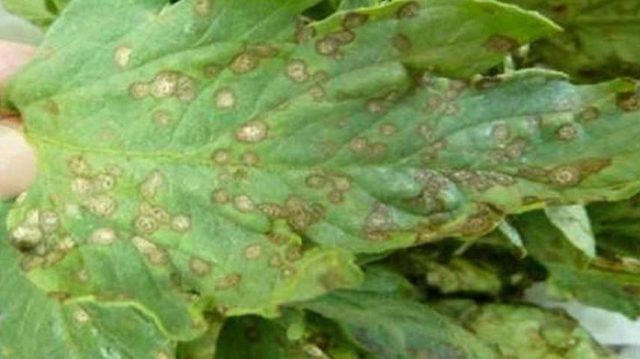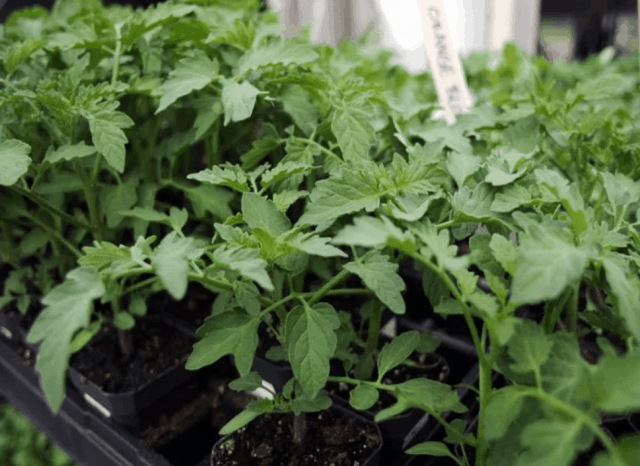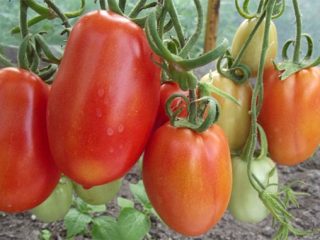Content
- 1 Description and photo of septoria
- 2 Reasons for appearance
- 3 Signs of occurrence
- 4 How dangerous is the disease?
- 5 How to treat white spotting on tomatoes
- 6 How to treat septoria on tomato seedlings
- 7 Tomatoes resistant to septoria
- 8 Prevention measures
- 9 Conclusion
- 10 Reviews about the treatment of tomato septoria
Tomatoes are a rather “capricious” and “delicate” crop. If there are serious errors in care, uncomfortable living conditions, or other problems, their immunity and stamina decrease, and they become susceptible to fungal and other diseases. One of the most common is septoria of tomatoes. It is quite possible to save bushes affected by the pathogen if the problem is noticed in time - there are effective folk remedies and commercial drugs. And simple prevention and competent agricultural technology significantly reduce the risk of developing the disease.
Description and photo of septoria
Septoria or white spot is a fungal disease that is characteristic not only of tomatoes, but also of many other garden crops. At the same time, the pathogen differs in its “specialization”: for example, a type of fungus that affects tomatoes is safe for grapes.
The experience of gardeners shows that bushes in “street” beds require treatment for septoria much more often than tomatoes in greenhouses and hotbeds. However, it is impossible to assume that plantings in closed ground are completely protected from the pathogen.
In Russia, the disease is widespread. In general, the “habitat” of the pathogen of tomato septoria blight coincides with the territories of the regions where they are cultivated.

A fairly mild temperate climate is considered optimal for the fungus.
Reasons for appearance
The fungus, overwintering in plant debris or surface layers of soil, ensures the primary infection of tomatoes. If nothing is done, the developing mycelium penetrates the surface tissues, new spores are formed, and the bush itself becomes infected with septoria for the second time, simultaneously spreading the pathogen.
Tomatoes can “catch” septoria not only from the soil. Fungal spores are carried by insects and gusts of wind; they are “washed away” from diseased bushes onto healthy raindrops and streams of water when watering.
Often bushes require treatment due to the fault of the gardener. He becomes a “carrier” of tomato septoria if he neglects to disinfect seeds before planting, containers, equipment, tools, and gloves. The fungus attacks healthy bushes, penetrating tissue through microcracks or more serious mechanical damage.
Also, the gardener may be “guilty” of neglecting weeding. Wild weeds from the Solanaceae family are suitable as “intermediate” hosts for the causative agent of septoria.From them it “spreads” to tomatoes and other garden crops, which then require treatment.

Plant debris is a “home” for many pests and pathogens
Signs of occurrence
The earliest sign of septoria is multiple, small (2-3 mm in diameter), as if “watery” spots on the front side of tomato leaves. After just a few days, they change shade to grayish-white, a brick-red border appears, gradually becoming brown.
If nothing is done, small black “grains” appear in the center of the growing spots. The part of the leaf blade not affected by them turns yellow. Then, without treatment, the leaves curl and fall off.

The first signs of tomato septoria blight appear on the oldest leaves; the top of the bush, even without treatment, often remains healthy in appearance
How dangerous is the disease?
The main danger of septoria for tomatoes is that without treatment it provokes “massive” leaf fall. “Bald” bushes are unable to provide themselves with nutrition and oxygen due to serious disruptions in the process of photosynthesis and metabolism.
The plant tries to “compensate for losses” with new leaves, but they turn out small and deformed. This takes all his strength, and accordingly, new buds and ovaries do not appear, and the ripening of fruits stops.

Without treatment, losses in tomato yield due to septoria are 25-40%
How to treat white spotting on tomatoes
In the early stages, septoria of tomatoes responds well to treatment, the disease goes away without negative consequences for the bushes.It is quite possible to get by with folk remedies and biological products. In the later stages of its development, chemicals with fungicidal properties are used. Agrotechnical methods are an effective means of “supporting” plants.
Agrotechnical methods
Competent agricultural technology helps to provide bushes with the most comfortable conditions for growth and development. The most important events:
- Planting bushes in a well-lit and sun-warmed place.
- Regular ventilation of the greenhouse to reduce air humidity. In open ground, tomatoes are planted in a place where they will have access to fresh air.
- Regulating watering depending on the weather outside. There is no specific scheme; it is necessary to focus on the condition of the bushes and substrate.
- Proper application of fertilizers. Bushes provided with everything they need are more powerful and stronger than those that are deficient in macro- and microelements. They are less likely to contract diseases and require treatment.
- Gradual removal of lower leaves. This reduces the risk of “catching” septoria from the ground and at the same time “redirects” most of the bush’s resources to fruit ripening.

It is not recommended to water tomatoes so that drops of water fall on the plants - this is another opportunity to “move” pathogens from diseased bushes to healthy ones
Folk remedies
There are quite a lot of folk remedies with antiseptic properties that can destroy fungi that cause septoria of tomatoes. To treat the disease in the early stages, use:
- A solution of table or sea salt (1 kg per 10 liters of water).
- Whey or kefir diluted with water (1 liter per 10 liters) with the addition of iodine (10-12 drops).
- A solution of potassium permanganate is bright pink (about half a teaspoon per 10 liters of water).
- Garlic infusion. Fill the container about a third with crushed heads or arrows, tamp lightly, add warm water to the brim. Infuse for 5-7 days in a dark, warm place under a tightly closed lid. Before use, strain and dilute with water 1:1.
- A decoction of horsetail or wormwood. Fresh herbs (200 g) are chopped, poured with a liter of boiling water, and kept on low heat for 30-40 minutes. The broth is cooled to room temperature and filtered. To treat tomatoes from septoria, it is poured into 10 liters of water.

Fermented milk products create an acidic environment that is harmful to pathogenic fungi.
Effective drugs for septoria of tomatoes
Regardless of the type of drug for treating tomatoes against septoria, it is used exactly following the instructions. We must not forget about personal protective equipment, even if the manufacturer indicates that it is completely safe for humans. The minimum set includes thick rubber gloves, goggles and a respirator.
Biological products have a short waiting period; they can be used even shortly before harvest. They do not begin to act immediately; in severe cases, they only slow down the development of tomato septoria, without providing complete treatment. They are also used for pre-planting seed treatment.
To treat tomatoes from septoria blight, they are treated with:
- Planriz;
- Alirin-B;
- Fitosporin-M;
- Bactofit;
- Maxim.
Agrochemicals are the most powerful tools at a gardener's disposal. This is associated with a quick and pronounced effect, a long “waiting period” after treatment.If used incorrectly, such preparations will cause more harm to plants and the environment than good, so any “amateur activity” when working with them is excluded.
You can get rid of white spotting on tomato leaves using:
- Fundazola;
- Ordana;
- Previcura;
- Oxychoma;
- Topaz.

The solution of most drugs for the treatment of tomato septoria must be used immediately
How to treat septoria on tomato seedlings
Tomato seedlings rarely need treatment for septoria. The use of agrochemicals will do more harm to seedlings than good. In addition, not all products can be used at home. If white spotting of tomatoes is noticed at an early stage, it is recommended to treat the seedlings with a biofungicide, and after 7-10 days, foliar feeding with a biostimulant.
Tomatoes resistant to septoria
There are no tomatoes that are completely resistant to septoria, despite the claims of seed manufacturers on the packages. This is just a marketing ploy. Breeders have so far managed to achieve greater resistance of certain varieties and hybrids to pathogen damage - they require treatment less often, even if the weather is favorable for the activation of the fungus, and the gardener makes mistakes in care.
Tomatoes that resist septoria blight better than others:
- The Golden Fleece;
- Amico;
- Platus F1
- Ballad;
- Worthy;
- Miracle F1
- Horeb;
- Beryl F1;
- Mondial;
- Joker;
- Dressed.

“Stress resistance” is one of the criteria that a gardener must take into account when choosing a variety.
Prevention measures
To avoid having to apply measures to treat tomatoes against septoria blight in practice, experienced gardeners strongly recommend studying in advance effective measures that can significantly reduce the risk of bushes being damaged by fungus and regularly applying them in practice:
- Taking into account the rules of crop rotation and “neighborhood” in the beds. When tomatoes and other Solanaceae are constantly planted in one place, spores of pathogenic fungi, including those that cause septoria, constantly accumulate in the soil. If you plant them in neighboring beds, there is an increased likelihood that your neighbors will also need treatment.
- Compliance with the landing plan. When the beds are “crowded”, an atmosphere is created that is conducive to the activation of the fungus.
- A competent selection of varieties and hybrids. They must be zoned for a given region. If the local climate is completely unsuitable for tomatoes, it is not a fact that they will survive at all and produce a harvest. And they will almost certainly need treatment for septoria and other diseases during the season.
- Disinfection of seeds of “dubious” origin before planting, including those collected independently. Septoria of tomatoes persists on the surface of the seed coats. If they are infected and the gardener neglects this stage of preparation, the bushes will need treatment already at the stage of growing seedlings.
- Antiseptic treatment of garden tools, equipment, gloves every time after work. Otherwise, the gardener himself may become a “carrier of infection,” including the causative agent of tomato septoria.
- Regular inspections of plantings. Walking around the beds at least once every 7-10 days, you can notice the first signs of septoria damage to tomatoes. At an early stage, treatment is much simpler, and the disease resolves with minimal negative consequences.
- Gartering bushes that “lie” on the bed, installing supports for them, removing the lower leaves touching the ground. Septoria, like many other fungi, is often “picked up” from the ground in tomatoes. Bushes with “bald” stems require treatment less often.
- Proper watering. A “swamp” in a garden bed is one of the main reasons contributing to the development of tomato septoria blight. Also, to avoid stagnation of water in the soil, regular loosening of the soil and mulching of plantings is recommended.
- Timely nitrogen fertilizing, correct dosage of fertilizers. With an excess of this macroelement in the soil, the immunity of tomatoes weakens, they become susceptible to septoria and other diseases.
- Autumn “cleaning” of the garden beds. The causative agent of tomato septoria successfully overwinters in plant debris. To ensure that the crop does not need treatment next season, all garbage is removed from the garden bed and burned. It is also recommended to dig up or loosen the soil well, and in the greenhouse, replace the surface layer of soil or disinfect it.

Treatment of the disease when trying to save space in the garden becomes more difficult, since the pathogen spreads faster
Conclusion
Septoria of tomatoes is easier to prevent than to cure, since the disease develops and spreads quite quickly, causing serious losses in the harvest.The best prevention in this case is competent agricultural technology; there are other effective measures, for example, planting varieties and hybrids that are better resistant to the pathogen. Biological products and folk remedies will help to cope with the disease in the early stages of development; in severe cases, agrochemicals with fungicidal properties are used.
Reviews about the treatment of tomato septoria









